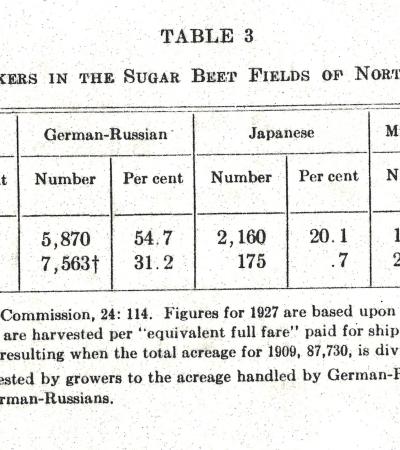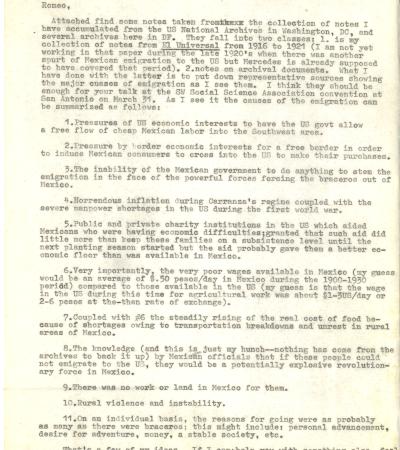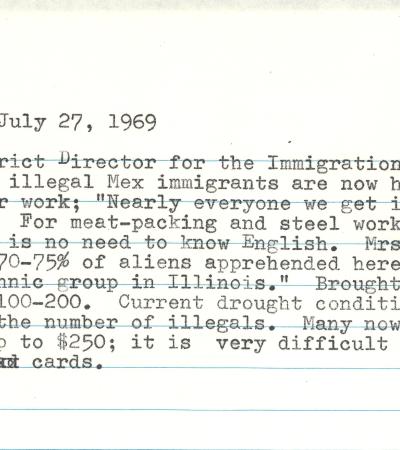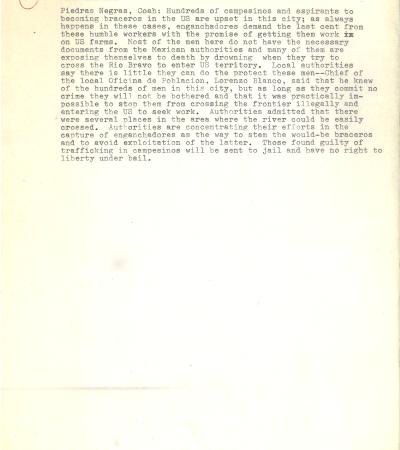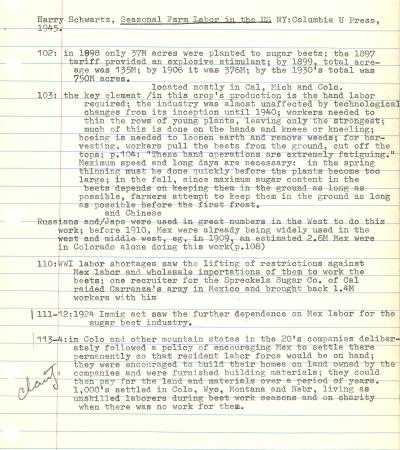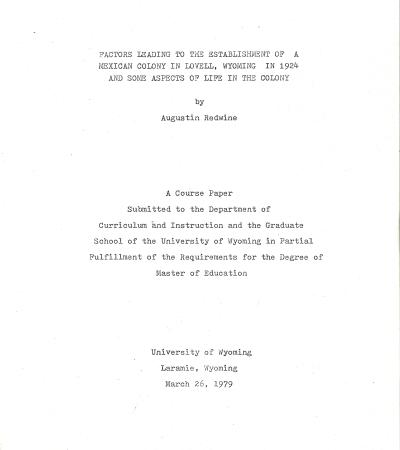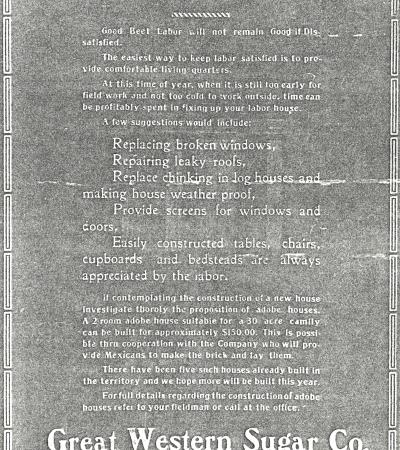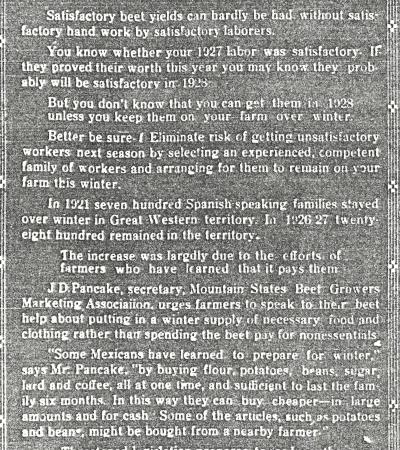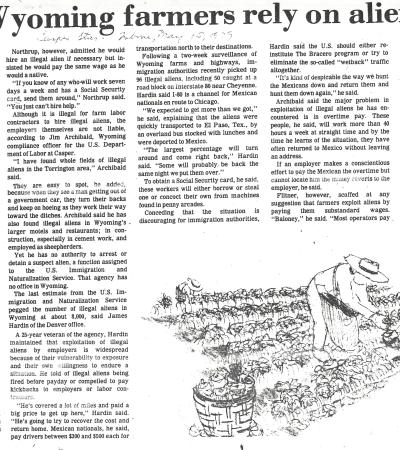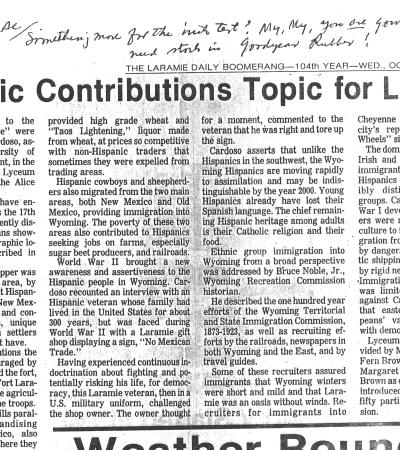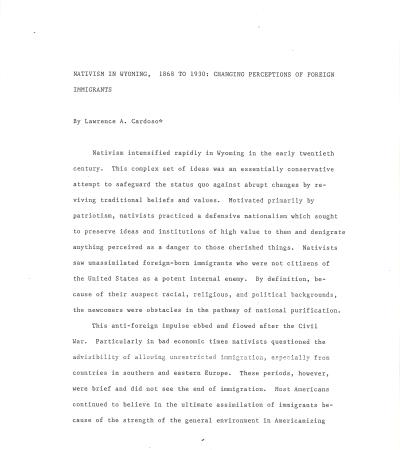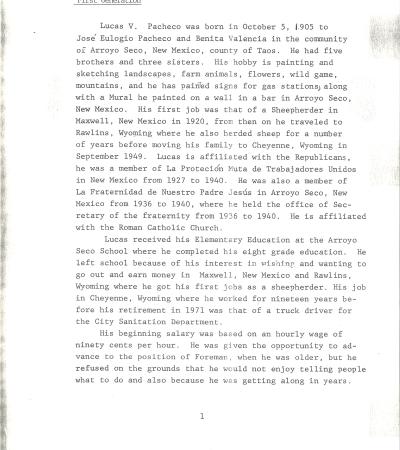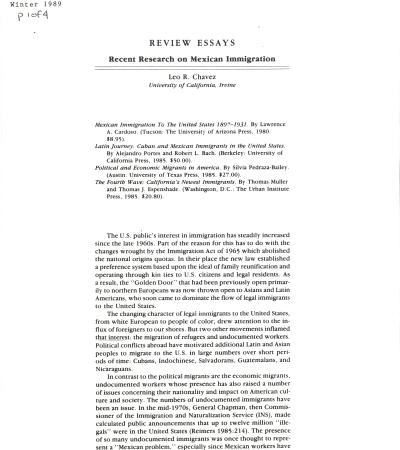Lawrence A. Cardoso (1940-1989) was a professor of history at the University of Wyoming from 1973 to 1989. His academic specialty was Mexican History. Among his papers are research materials for books and papers he authored about Mexican history, Mexican emigration, and the history of Mexican immigrants and immigrant communities in Wyoming.
Table Showing Trends in Nationalities Among Sugar Beet Workers
This table shows the dramatic increase in number of Mexican sugar beet laborers working in Colorado between the years of 1909 and 1927. Some Colorado laborers eventually came to Wyoming.
Notes on Causes of Emigration from Mexico, March 6, 1972
Cardoso's notes summarize the causes of emigration from Mexico. They also include notes from archival documents from the 1920s and 1930s.
Notes from the Houston Post, July 27, 1969
These notes, taken from a newspaper article, discuss changes in immigration patterns, with more immigrants headed for city jobs, particularly in Chicago.
Notes from El Universal, February 17, 1972
These notes, taken from a Mexican newspaper article, discuss the situation in Piedras Negras, Mexico, where emigrants prepare to enter the U.S.
Notes from Seasonal Farm Labor in the U.S., 1945
These notes, taken from a book written by Harry Schwartz, are focused on immigrant labor and the sugar beet industry.
"Factors Leading to the Establishment of a Mexican Colony in Lovell, Wyoming in 1924" by Augustin Redwine, March 26, 1979
This paper examines the economic and social factors that led to the creation of a Mexican labor colony in Lovell, Wyoming. It highlights the role of the sugar beet industry in attracting Mexican migrant workers, the challenges they faced in terms of discrimination and labor conditions, and how they established a close-knit community while navigating their place in a predominantly Anglo-American society.
"Life in Lovell Mexican Colony" by Anna Parks, The Lovell Chronicle, June 21, 1984
This newspaper article describes the history and vibrant community of the Mexican Colony in Lovell, Wyoming, which housed sugar beet laborers beginning in the 1920s. It highlights personal stories of residents, tales of hardship and resilience, and the eventual demolition of the Colony in 1955.
"Labor Houses", February 17, 1928
This newspaper notice, posted by the Great Western Sugar Company, encourages beet farmers to provide comfortable living quarters for their Mexican laborers. It suggests making repairs to existing houses and the construction of new adobe houses.
"Next Year's Beet Help is Now Ready", November 12, 1927
This newspaper notice, posted by the Great Western Sugar Company, asks beet farmers to encourage their laborers to stay at their farms over the winter.
"Some Wyoming farmers rely on alien labor" by Joan Barron, Casper Star-Tribune, May 15, 1979
The newspaper article discusses the reliance of Wyoming farmers on migrant labor, particularly undocumented Mexican workers, to fill labor shortages in sugar beet fields. It highlights tensions between immigration enforcement, labor needs, and accusations of worker exploitation.
"UW Professor says illegal Mexicans unstopable" by Emily Quarterman, Casper Star-Tribune, December 17, 1983
The newspaper article discusses University of Wyoming professor Lawrence Cardoso’s argument that illegal Mexican immigration to the United States is an ongoing and inevitable phenomenon driven by economic factors. He highlights the reliance of American agriculture on migrant labor, the failure of policies attempting to curb immigration, and the long-term implications of increased Hispanic presence in the U.S. workforce.
"Hispanic Contributions Topic for Lyceum", The Laramie Daily Boomerang, October 10, 1984
The newspaper article discusses a lecture by University of Wyoming Professor Lawrence Cardoso, highlighting the historical presence and contributions of Hispanics in Wyoming, dating back to Spanish explorers and early fur traders. Cardoso emphasizes the assimilation of Wyoming Hispanics, the impact of World War II on Hispanic identity, and the broader context of ethnic immigration patterns in the state.
"Nativism in Wyoming" by Lawrence A. Cardoso
This paper discusses changing perceptions of foreign immigrants in Wyoming from 1868 to 1930. In particular, it examines the rise of nativism in Wyoming, which intensified in the early 20th century due to fears of foreign influence and changing demographics. While early attitudes towards immigrants were generally welcoming, particularly for economic development, World War I and post-war instability fueled widespread anti-immigrant sentiment, leading to restrictive laws, forced assimilation efforts, and support for national immigration quotas to preserve a homogeneous American identity.
Interview Summaries, 1983
These interview summaries are taken from interviews of 3 generations of a Hispanic family living in Cheyenne. They give insight into the evolution of one Wyoming family's experience in light of their Mexican heritage.
"Review Essays on Recent Research on Mexican Immigration" by Leo R. Chavez, 1989
The document discusses recent scholarly works on Mexican immigration to the United States, analyzing both historical and contemporary migration patterns. It highlights the role of economic and political factors in shaping migration, and emphasizes the structural relationship between Mexico and the U.S. in labor movements.
